
Utricularia multifida, commonly called pink petticoat or fairy aprons, is a terrestrial carnivorous plant that belongs to the bladderwort genus, Utricularia, of family Lentibulariaceae. It is endemic to the south west corner of Western Australia. It was once placed in a separate genus as Polypompholyx multifida.
Utricularia quinquedentata is an annual, terrestrial carnivorous plant that belongs to the genus Utricularia. Its distribution ranges across northern Australia from Western Australia to northern Queensland and south to Brisbane. It was first identified by Ferdinand von Mueller as possibly a new species or variety in the early 1890s, noting it as "U. albiflora or a closely allied species." Mueller labeled one herbarium sheet as Utricularia albiflora var. quinquedentata. Without a valid description, according to the rules of botanical nomenclature, however, the epithet quinquedentata was not recognized until Peter Taylor validly published the species in 1986.

Utricularia volubilis, the twining bladderwort, is a perennial, affixed aquatic carnivorous plant that belongs to the genus Utricularia. It is endemic to the southwestern coastal region of Western Australia.
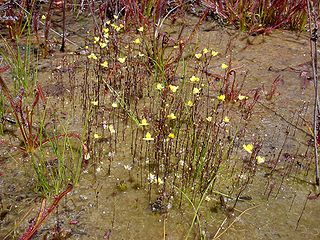
Utricularia subulata, the zigzag bladderwort, is a small annual, terrestrial carnivorous plant that belongs to the genus Utricularia. It is the most widely distributed species in the genus, being almost pantropical.
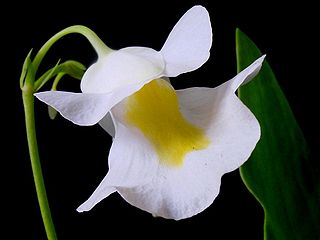
Utricularia subg. Utricularia is a subgenus in the genus Utricularia.
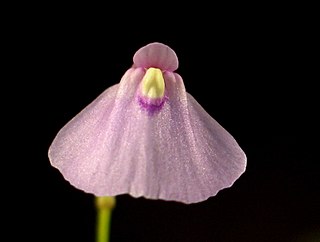
Utricularia sect. Pleiochasia is a section in the genus Utricularia.

Utricularia subg. Polypompholyx is a subgenus in the genus Utricularia.
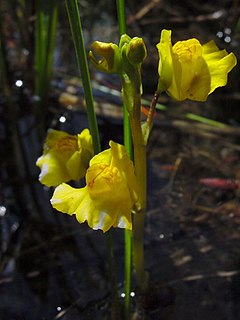
Utricularia sect. Utricularia is a section in the genus Utricularia. The species in this section are suspended or affixed aquatic carnivorous plants.

Utricularia aurea, the golden bladderwort, is a medium- to large-sized suspended aquatic carnivorous plant that belongs to the genus Utricularia. It is the most common and widespread suspended aquatic species in Asia. Its native distribution ranges from India to Japan and Australia.
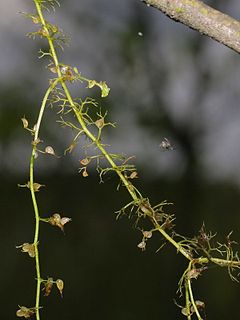
Utricularia minor, the lesser bladderwort, is a small, perennial carnivorous plant that belongs to the genus Utricularia. It is usually found affixed to the substrate but it can also survive suspended in a body of water. U. minor is a circumboreal species and is found in North America, Asia, and Europe.

Utricularia intermedia, the flatleaf bladderwort or intermediate bladderwort is a small, perennial carnivorous plant that belongs to the genus Utricularia. It is usually found affixed to the substrate but it can also survive suspended in a body of water. U. intermedia is a circumboreal species and is found in North America, Asia, and Europe.

Utricularia radiata, the little floating bladderwort, is a medium-sized suspended aquatic carnivorous plant that belongs to the genus Utricularia. U. radiata is endemic to North America.

Utricularia stellaris is a medium to large sized suspended aquatic carnivorous plant that belongs to the genus Utricularia. U. stellaris is native to Africa, tropical Asia, and northern Australia.

Utricularia purpurea, the eastern purple bladderwort, is a medium-sized suspended aquatic carnivorous plant that belongs to the genus Utricularia. U. purpurea is endemic to North and Central America. It has been suggested that U. purpurea may have partially lost its appetite for carnivory. Richards (2001) did an extensive study in the field on it and noted that trapping rates of the usual Utricularia prey were significantly lower than in other species in the genus. Richards concludes that this species can still trap and digest arthropod prey in its specialized bladder traps, but does so sparingly. Instead, it harbors a community of algae, zooplankton, and debris in the bladders that indicates U. purpurea favors a mutualistic interaction in place of a predator–prey relationship.

Utricularia sect. Orchidioides is a section in the genus Utricularia. The species in this section are small or medium-sized terrestrial or epiphytic carnivorous plants native to Central and South America. Alphonse Pyrame de Candolle originally published this section in 1844. In 1916, John Hendley Barnhart moved the section to its own genus, Orchyllium, recognizing that the species in this section are distinct. Several other botanists, including Henry Gleason, considered the treatment of these species in the genus Orchyllium valid and moved other species from Utricularia to Orchyllium. Ultimately the species were all reunited under Utricularia.

Utricularia subg. Bivalvaria is a subgenus in the genus Utricularia. It was originally described by Wilhelm Sulpiz Kurz in 1874. In Peter Taylor's 1989 monograph on the genus, he reduced the subgenus to synonym under section Oligocista, a decision that was later reversed in the light of molecular phylogenetic studies and the subgenus was restored.
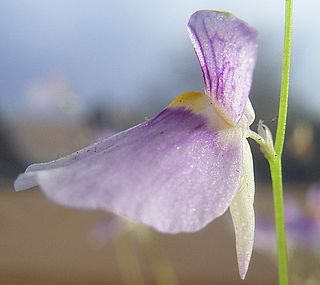
Utricularia sect. Aranella is a section in the genus Utricularia. The ten species in this section are small terrestrial carnivorous plants native to tropical South America with one species also extending into tropical Africa. John Hendley Barnhart originally described and published this section in 1913 as a separate genus, Aranella. Sadashi Komiya revised the genus Utricularia in a 1973 taxonomic review and placed Barnhart's genus at the rank of subgenus within Utricularia. Peter Taylor then published his taxonomic monograph of Utricularia in 1986 in which he reduced Komiya's subgenus to the rank of section, placing it within subgenus Utricularia. More recent phylogenetic data and revisions have reinstated subgenus Bivalvaria and have placed this section within it.

Utricularia sect. Calpidisca is a section in the genus Utricularia. The ten species in this section are small terrestrial carnivorous plants native to Africa with one species extending its range into Mexico and another that extends into Asia as far as India. John Hendley Barnhart originally described and published this section in 1916 as a separate genus, Calpidisca. Sadashi Komiya revised the genus Utricularia in a 1973 taxonomic review and placed Barnhart's genus at the rank of section within Utricularia. Peter Taylor then published his taxonomic monograph of Utricularia in 1986 in which he placed Komiya's section within subgenus Utricularia. More recent phylogenetic data and revisions have reinstated subgenus Bivalvaria and have placed this section within it.

Utricularia sect. Oligocista is the largest section in the genus Utricularia. The 42 species in this section are small to medium-sized terrestrial carnivorous plants native throughout the tropics, with six species in the Americas, ten in Africa, five in Australia, and the remainder in Asia, with 17 mostly native to peninsular India. Alphonse Pyrame de Candolle originally described and published this section in 1844. Peter Taylor published his taxonomic monograph of Utricularia in 1986, in which he placed this section within subgenus Utricularia. More recent phylogenetic data and revisions have reinstated subgenus Bivalvaria and have placed this section within it.
Utricularia sect. Phyllaria is a section in the genus Utricularia. The sixteen species in this section are small or very small lithophytic or epiphytic carnivorous plants native to the mountains of Asia, ranging from India to China and New Guinea. One species, Utricularia striatula, is an exception and is widespread in much of the Old World tropics. Wilhelm Sulpiz Kurz originally described and published this section as Utricularia subg. Phyllaria in 1874. Franciszek Kamieński reviewed the genus in 1891 and reduced Kunz's subgenus to a section. Later botanists, including Peter Taylor, agreed with Kamieński's assessment. In Taylor's 1986 revision of the genus, he placed this section in subgenus Utricularia. Later molecular data resulted in the revision of Taylor's treatment, reinstating subgenus Bivalvaria and placing this section within it.















